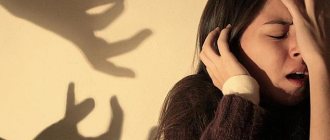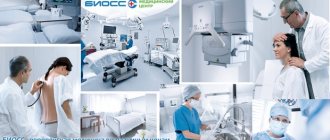Severe neurosis and asthenic neurasthenia
Reactive severe asthenia can occur with severe neuroses. The disease is complemented by the following clinical signs:
- absentmindedness;
- forgetfulness;
- autonomic disorders - unexplained difficulty breathing, sweating, changes in blood pressure, increased heart rate;
- high level of anxiety;
- increased fears and phobias;
- decreased sex drive;
- fluctuations in appetite;
- increased sensitivity to bright light and loud sounds;
- impaired speed and quality of thinking (cognitive dysfunction);
- concomitant depressive (affective) clinic.
However, the diagnosis of neurasthenia has now lost its relevance; it was removed from the ICD 11th revision (2019). The problem lies in the inaccuracy of the pathogenetic mechanisms, and the symptoms can be placed within the framework of other diseases and conditions.
In adult men
The course of affective disorders is individual, the dependence on gender is almost not expressed. However, men may have other prerequisites for developing the disease. For example, they more often become participants in hostilities or suffer financial (career) failures more difficult.
The social roles that are imposed on boys from an early age increase the demands placed on themselves. Young men start working earlier in an effort to achieve success, which exposes them to high levels of stress. We must not forget that personal characteristics are different for all people, that is, not everyone can withstand the pressure applied.
Over the years, the condition worsens due to chronic fatigue, family problems, and aging. Losing a job or wife in middle age often becomes a critical moment when adaptation mechanisms are disrupted. At the same time, men are less likely to go to doctors, not wanting to show their own weaknesses, or even completely deny the existence of a problem.
Among women
Now women are trying to share the same social functions as men, while caring for children and maintaining everyday life. An exaggerated sense of responsibility leads to them taking on too many responsibilities. Unofficially, psychiatrists call this the “hunted horse” syndrome.
Prolonged intellectual and psychophysical overstrain becomes a trigger for the development of affective disorders. Another common cause of asthenic depression in women is the pre/postpartum period. Violations are aggravated against the background of hormonal imbalance, as well as in the absence of support from loved ones.
In children
Unfortunately, children are also susceptible to developing the disease. The normal development of the psyche largely depends on obtaining a positive emotional experience, adequate upbringing, and a “healthy” social environment. Vulnerability is determined not only by age, but by a person’s personal characteristics.
Children may experience all the symptoms characteristic of asthenic depression. However, they cannot always correctly formulate their concerns or are completely silent about them. The painful condition is hidden behind complaints of boredom, strange pains, and restless sleep.
As the disorder worsens, the child begins to distance himself from others, stops taking part in games, and moves away from peers. A decline in academic performance leads to conflicts in the family and school. It is not uncommon to skip classes, run away from home, and spend time alone.
The appearance of depressive behavior at a young age should alert parents and teachers. Children often remain silent about bullying at school, cases of violence (including sexual violence), and disharmonious relationships in the family. Lack of timely treatment causes delayed psychomotor development, the occurrence of more severe diseases, and suicidal behavior.
Signs and symptoms of astheno-neurotic syndrome
The syndrome is manifested by physical fatigue, weakness, inability to engage in long-term physical and mental exercise, and increased irritability. A diagnosis can be suspected if the following clinical picture is observed: pronounced disorders of the autonomic nervous system; nonspecific subjective complaints about disturbances in the functioning of various organs; in some cases, in reality, there may be minor changes in their functions (for example, flatulence, hiccups). However, in general, the functioning of organs and systems is preserved. People of a hysterical disposition are especially susceptible to the manifestation of the syndrome.
In general, the symptoms of astheno-neurotic syndrome can be divided into:
- Somatovegetative disorders: dizziness, rapid heartbeat, chest pain, shortness of breath, feeling of lack of air or a lump in the throat, hand tremors, muscle spasms, sweating, nausea, stomach discomfort, frequent urge to urinate. These manifestations are often combined with phobias and anxiety.
- Somatoform disorders: complaints of various symptoms of diseases (short-term pain, burning, etc.), craving for new medical examinations in the absence of real pathologies.
Symptoms of ANS
Characteristic manifestations of asthenoneurosis are rapid fatigue and chronic fatigue. Children have difficulty shifting their attention, their thinking is inhibited, and their memory is weak. Schoolchildren are unable to concentrate in class, they are fussy, and motor reflexes are noticeable. Teachers usually recognize the initial phases of the syndrome as bad manners, so they complain to parents, but they are in no hurry to visit the clinic.
The next typical category of symptoms is psycho-emotional disorders. The child is subject to sudden mood swings for no apparent reason; he experiences nervousness and increased irritability. Usually there is a pathologically bad mood, which gradually develops into depression. Teenagers react too emotionally to even quite minor events. Typical symptoms of the disease are:
- moodiness;
- enuresis;
- frequent headaches;
- mood swings;
- weak immunity, prone to colds;
- irritability, manifestations of anger, aggression;
- increased sweating;
- loss of appetite;
- low academic performance;
- nausea in transport;
- poor social adaptation.
Asthenoneurosis is manifested by touchiness, the presence of phobias, aggression, and the search for physical ailments. Children feel broken and sick, although in reality there is nothing like that.
Forms, stages and types of astheno-neurotic syndrome
The disease develops in acute or chronic form. The first is of a functional nature; it appears after severe stress, an infectious or other severe somatic disease. The second (usually organic in nature) has a long course. This form also includes chronic fatigue syndrome.
The disease has several stages, depending on the strength, duration and nature of mental trauma:
- The hypersthenic stage is characterized by hyperexcitability, irritability, fatigue, and excessive reaction to minor stimuli. Over time, symptoms become more frequent and persist for a long time.
- The hyposthenic stage is characterized by physical and nervous exhaustion, depression, drowsiness, passivity, and decreased performance. Possible tachycardia, cardialgia, dizziness, intestinal dysfunction, disorders of the genitourinary system, loss of appetite.
From the point of view of etiology, a distinction is made between reactive neurasthenia, which occurs against the background of stress, excessive emotions, and secondary (somatogenic, organic).
The syndrome can manifest itself with a predominance of symptoms of mental fatigue - inability to concentrate, lack of concentration, absent-mindedness, weakening of memory, or physical ill health - general weakness, muscle pain, inability to relax. However, both forms are characterized by the following common symptoms: dizziness, headache, irritability, anxiety, sleep disturbance.
Astheno-neurotic syndrome in children
Children are characterized by lability of neuropsychic processes and rapid fatigue, so any somatic or infectious diseases can be accompanied by symptoms of asthenia. The longer the disease lasts, the higher the likelihood of developing a neurotic syndrome.
Prerequisites for asthenia include increased stress at school and in extracurricular activities (clubs, sections). The risk of developing neurotic syndrome is increased in those who have an unhealthy microclimate in the family, school, and problems in relationships with peers.
A special category consists of children who had lesions of the central nervous system during fetal development, during childbirth or in the early neonatal period. This may become an additional risk factor for the development of astheno-neurotic syndrome.
Diagnosis of the disease
The diagnosis of astheno-neurotic syndrome is established by a qualified specialist - a neurologist or psychotherapist after a clinical and anamnestic examination. Pathopsychological research is carried out by a medical psychologist, recording deviations from the norm by conducting special tests on the way of thinking, memory, and concentration.
To identify the causes of this condition and exclude organic lesions of the central nervous system, echoencephalography, electroencephalography, computer and magnetic resonance therapy are performed. If necessary, a consultation with specialists is prescribed - a neurologist, sexologist, psychiatrist.
Prevention of asthenia
Sarklinik has developed an effective program “ Prevention of asthenia ”, which allows you to avoid future exhaustion of the nervous system. A healthy nervous system is a reality today. The peculiarity of the disease is that the symptoms slowly, gradually, but clearly increase, and the condition worsens sharply. Do not expect dangerous complications of asthenia, asthenic syndrome; contact Sarclinic for timely treatment.
Sign up for a consultation. They have contraindications. Specialist consultation is required.
Photo: (©) Bds | Dreamstime.com \ Dreamstock.ru The people depicted in the photo are models, do not suffer from the diseases described and/or all similarities are excluded.
Related posts:
Facial nerve, facial nerve neuritis, treatment, inflammation, paresis, neuritis, neuropathy, facial nerve neuralgia
Poor attention: absent-mindedness, exhaustion, narrowing of scope, stiffness, distractibility
Trigeminal nerve, inflammation, treatment, trigeminal neuralgia, symptoms, how to treat
Enuresis, bedwetting in children, treatment, child peeing at night
Incontinence, treatment of incontinence in Saratov, Russia, symptoms, signs, causes, types
Comments ()
How to treat astheno-neurotic syndrome?
The goal of treatment is to achieve stable remission. It is carried out in three main areas:
- etiopathological treatment;
- nonspecific, restorative and immunocorrective therapy;
- symptomatic therapy.
Drug therapy supplemented with psychotherapeutic methods has a positive effect. A psychotherapist helps to find out and understand the causes of the disease, to form the right attitude towards it through individual and group classes, trainings, art therapy, cognitive behavioral therapy, etc.
The basis for the treatment of astheno-neurotic syndrome in children is non-drug methods aimed at normalizing the child’s lifestyle. Parents must monitor not only the child’s compliance with the daily routine, diet, and avoid overload, but also the preservation of psychological comfort in the family and educational institution (sometimes it may be necessary to change schools). The diet should consist of foods rich in B vitamins (offal, whole grain bread, eggs), tryptophan (lean meat, cheeses). It is recommended to exclude carbonated drinks, chips, and crackers. Additional conversations should be held with teenagers about the harm of alcoholic drinks and energy drinks, which give a feeling of cheerfulness for a short time, but generally worsen the patient’s condition. To resolve internal conflicts, eliminate traumatic situations or change attitudes towards them, long-term work with psychologists is indicated.
Cure for astheno-neurotic syndrome
The treatment strategy can be divided into three basic areas:
- etiopathogenetic treatment of the underlying disease;
- nonspecific, restorative and immunocorrective therapy;
- symptomatic therapy.
For psychopharmacological therapy, drugs of different groups are used: vitamin-mineral complexes, antidepressants, nootropics, tranquilizers and antipsychotics.
During the treatment of astheno-neurotic syndrome, vitamins, macro- and microelements are recommended. In particular, the patient’s body needs a greater supply of vitamin C, which is typical for the recovery period after serious illnesses or prolonged stay in stressful situations. A lack of B vitamins is recorded in the case of somatogenic asthenia. And vitamin B5 (pantothenic acid) is generally called an anti-stress vitamin. Vitamin B2 (riboflavin) is involved in energy metabolism, which is also important for increasing the patient’s tone. Iron, phosphorus, manganese are indispensable for the normal functioning of enzymes involved in energy processes. Potassium and magnesium also play a significant role in the treatment of manifestations of astheno-neurotic syndrome.
Basic therapy for astheno-neurotic syndrome is tranquilizers and antidepressants. If the syndrome is combined with expressive hysterical, hypochondriacal manifestations, or phobias, low doses of antipsychotics are added to the basic therapy. The choice of drug, dose and course of treatment is determined by the doctor.
Among over-the-counter drugs, homeopathic remedies (Hepel) and sedative herbal medicines (valerian extract, Persen, Novo-Passit) have proven themselves well.
Non-drug methods of treating the disease (as well as its prevention) include: a healthy lifestyle, moderate physical activity, adequate sleep, and giving up bad habits.
Treatment of asthenovegetative syndrome
If asthenovegetative syndrome is detected in the early stages, then in this case you can do without medication treatment; it will be enough to give up heavy loads of any nature, normalize your lifestyle and diet, and sometimes just rest. In more complex cases, complex therapy is used, which includes: taking vitamins, massage and physical therapy, electrophoresis, baths with soothing essential oils. Neurometabolic drugs and herbal nootropics may also be prescribed.
In the most severe cases, medication cannot be avoided. Antidepressants (antipsychotics and antipsychotics) will help correct the patient’s condition. An individual approach is very important, taking into account age (a child and an adult have different nervous systems) and the general condition of the body. With the level of modern medicine, the development of the disease can be easily minimized.
List of used literature
- Grishchenko E.V. Methods for correcting asthenic syndrome in outpatient practice // “medical council”, 2012 - p. 36-37
- Kolyutskaya E. V. Modern approaches to psychopharmacotherapy of anxiety disorders // Pharmaceutical Bulletin: information and analytical newspaper. 2005. - p. 112-116
- Vein L. M., Voznesenskaya T. G., Vorobyova O. V. et al. Autonomic disorders: clinical picture, treatment, diagnosis / ed. A. M. Veina. M.: medical information agency. - 1998. - 752 p.
Popular questions about astheno-neurotic syndrome
How dangerous is astheno-neurotic syndrome?
If not treated in time, it can cause hormonal disorders, disorders in the digestive tract (stomach ulcer), cardiovascular system (up to the development of heart attacks and strokes), the development of depressive states, and the appearance of suicidal thoughts.
How long to treat astheno-neurotic syndrome?
The drug and course of treatment are determined by the patient’s condition and concomitant pathologies, and therefore are prescribed by the doctor individually.
Which doctor treats astheno-neurotic syndrome?
Neurologist, psychotherapist.
When does it occur and how long does it last?
It is an officially recognized fact that in some cases a person who has recovered from a coronavirus infection suffers from its consequences for a long time, and the severity of the post-Covid syndrome does not depend on the severity of the disease, age, health status and other factors. It is customary to refer to post-Covid syndrome as symptoms that last more than 12 weeks, are changeable, characterized by a wave-like course, and cannot be explained by any other reasons. The syndrome can occur immediately after suffering from Covid or after some time.








